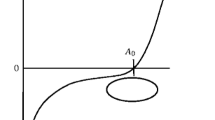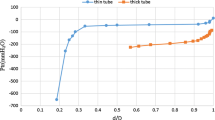Abstract
Indirect evidence links self-excited oscillation of flow through collapsed tubes with choking, defined by the cross-sectionally averaged fluid speed u reaching the local speed of small pressure waves c. This was tested by measuring both c-u and c as functions of tube cross-sectional area during self-excited oscillation, using small superimposed high-frequency wave packets. The wavespeed c was derived from the local slope of the pressure/area relationship, measured at both high and low frequency, while c-u was taken as the upstream propagation rate of the pressure disturbances. When u=0, these were shown to agree with each other. The propagation results showed that choking did not occur at high frequency. At the low frequency of the self-excited oscillation the results were less conclusive, because of dispersion and indirect methodology, but choking appeared not to happen at the modest flow rate of the oscillation investigated. Results on the attneuation of the wave packets were successfully explained using a model of the tube throat consisting of two equal and opposite reflection sites.
Similar content being viewed by others
References
Anliker, M., Histand, M. B. andOgden, E. (1968) Dispersion and attenuation of small artificial pressure waves in the canine aorta.Circ. Res.,23, 539–551.
Bertram, C. D. (1986) Unstable equilibrium behaviour in collapsible tubes.J. Biomech.,19, 61–69.
Bertram, C. D. (1987) The effects of wall thickness, axial strain and end proximity on the pressure-area relation of collapsible tubes.,20, 863–876.
Brower, R. W. andScholten, C. (1975) Experimental evidence on the mechanism for the instability of flow in collapsible vessels.Med. & Biol. Eng.,13, 839–845.
Cancelli, C. andPedley, T. J. (1985) A separated-flow model for collapsible tube oscillation.J. Fluid Mech.,157, 375–404.
Dardel, E. (1988) Wave propagation and flow velocity profiles in compliant tubes.Med & Biol. Eng. & Comput.,26, 46–49.
Gerrard, J. H. (1985) An experimental test of the theory of waves in fluid-filled defomable tubes.J. Fluid Mech.,156, 321–347.
Holt, J. P. (1959) Flow of liquids through collapsible tubes.Circ. Res.,7, 342–353.
Jensen, O. E. andPedley, T. J. (1989) The existence of steady flow in a collapsed tube.J. Fluid Mech.,206, 339–374.
Kececioglu, I., McClurken, M. E., Kamm, R. D. andShapiro, A. H. (1981). Steady, supercritical flow in collapsible tubes. Part 1. Experimental observations.,109, 367–389.
Lighthill, M. J. (1978)Waves in fluids. Cambridge University Press.
Pedley, T. J. (1980).The fluid mechanics of large blood vessels. Cambridge University Press, Chap. 6.
Shapiro, A. H. (1977) Steady flow in collapsible tubes.Trans. ASME, J. Biomech. Eng.,99, 126–147.
Womersley, J. R. (1957) Oscillatory flow in arteries: the constrained elastic tube as a model of arterial flow and pulse transmission.Phys. in Med. & Biol.,2, 178–187.
Author information
Authors and Affiliations
Rights and permissions
About this article
Cite this article
Bertram, C.D., Raymond, C.J. Measurements of wave speed and compliance in a collapsible tube during self-excited oscillations: a test of the choking hypothesis. Med. Biol. Eng. Comput. 29, 493–500 (1991). https://doi.org/10.1007/BF02442320
Received:
Accepted:
Issue Date:
DOI: https://doi.org/10.1007/BF02442320




